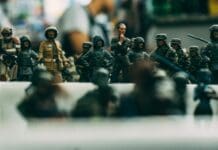This post is also available in:
 עברית (Hebrew)
עברית (Hebrew)

If we think of sensitive, complex cities in the modern Middle East that are highly volatile, reflect sectorial tensions, and are home to serious acts of violence, the first names that come to mind are likely to be Baghdad, Mosul, Beirut, and even Jerusalem. However, perhaps it is actually Tripoli in Lebanon that is a microcosm of dramatic regional phenomena and trends and offers a vivid contemporary case study. Located on the northern coast of the Mediterranean, Tripoli, Lebanon’s second largest city, has in recent years been home to another round in a long cycle of violence.
This article attempts to provide a broad context for the tempest in Tripoli, focusing on the domestic situation in Lebanon and the civil war in Syria, and deriving insights from what has emerged thus far. To this end, it takes a combined look at Syria and Lebanon, as this is the only way to shed light on the situation and allow an in-depth examination of its consequences. The challenging situation in Tripoli has crucial importance for the future, both inside and outside of the city.
While Tripoli has belonged to Lebanon for nearly 100 years and was unquestionably the keystone in the building of the Lebanese state, what takes place there, cannot be separated from the remaining vestiges of Syrian political and social culture. Prior to the contemporary turmoil in the Arab world, such a statement could have been considered archaic and a distortion of the modern geopolitical fabric of the region. However, today this cannot be dismissed – and all the more so given the weakening of the state structure in the wake of the changes that have occurred. The recognizable borders that divided between the national entities established over the previous 100 years have been blurred, and distinct identities based on religion, ethnicity, community, society, economics, and culture have risen to the surface. It is no wonder, therefore, that a city such as Tripoli, whose demographic makeup and common traditions differ little from those of Syria, reflects the strengthening of the Middle East sectorial trend within its territory, and in particular, the trend that has grown stronger in Syria. The first element of the spillover of the Syrian war to Tripoli concerns the city’s Alawites. This large community, based in the Jabal Mohsen neighborhood, numbers 40,000-60,000 people. It is the largest concentration of Alawites in Lebanon, and more than half of Lebanon’s Alawites live there.
Traditional Sunnis naturally identify the Alawites with Shiism, and hence there is an inherent tension between the Alawite minority and the Sunni majority in the city. Moreover, many in the Middle East do not even consider the Alawites to be Muslims. Nevertheless, in Lebanon too the Alawites remained a minority, and in Tripoli, the situation intensified as Jabal Mohsen residents were perceived by the city’s Sunnis as representatives of the Assad regime. Syria’s involvement in Lebanon from the day of its establishment, which increased during the civil war and afterwards, aroused the ire of much of Lebanese society against the patronage of the state’s big sister. The Sunnis constitute a significant part of the anti-Syrian movement in the country, which does not take a favorable view of the close connection between the Assad regime and elements in Lebanon – primarily Hizbollah – that has grown closer since Assad’s death and the ascent of his son Bashar to power in 2000.
The clashes between the residents of Jabal Mohsen and Bab al-Tabbaneh have continued with fluctuating intensity, against the backdrop of critical events such as the murder of Rafiq al-Hariri, the withdrawal of Syrian troops from Lebanon in 2005, and the crisis in the country in 2007-8. The latest milestone on the road to the current events was the outbreak of the Syrian civil war in March 2011.
In Lebanon, where the wounds from its own civil war have not yet healed and sectarian rifts are contained in a delicate balance to prevent another round of violence, the events in the neighboring state are read loud and clear. Every ethnic group and community has drawn its own conclusions according to the sensitivities and interests on its agenda. Sunni residents of Tripoli, many of whom have moved closer to Salafist Islam over the years, largely thanks to the conservative Muslim tradition that is an integral part of the city, have felt a deep solidarity with the Sunni population in Syrian cities in face of the conduct of the Assad regime toward this population.
Register to iHLS Israel Homeland Security
After initial success, several factors combined to force Lebanon to become involved in various aspects of the struggle across the border on a larger scale than it wished. The first concerned the flood of Syrian refugees into Lebanon. More than one million refugees poured into the country, a large percentage of them Sunni Muslims, and about one-quarter settled in the Tripoli area. This dramatic fluctuation in the demographic makeup of the country led the authorities to adopt a tougher immigration policy in order to stop the trend jeopardizing Lebanese society, and in late 2014 steps were taken toward this end. The second factor is the dual problem of involvement by Lebanese elements in the fighting in Syria. The first, which thus far has played the most significant role, is Hizbollah’s decision – possibly taken voluntarily and possibly because of the dictates of Tehran – to stand by Bashar Assad and fight alongside his army in the struggle against the rebels. This choice subjected the organization to harsh criticism domestically, particularly from anti-Syrian elements in the country represented by the March 14 Alliance, for forcibly dragging Lebanon into an unnecessary conflict. This criticism, however, has yielded little, and Hizbollah is still entrenched in the fighting in Syria, mostly along the border with Lebanon. The organization casts itself as the defender of Lebanon and is fully supported by the March 8 Alliance, which it heads.
Within the turbulent Middle East, which abounds with opposing factions, a number of islands remain that were damaged less by the ravages of the storm. Lebanon was and still is such an island. Despite the delicate balance among the communities and the security, political, economic, demographic, and social crises it faces, the long-suffering country has thus far known how to contain the conflict and to maintain its integrity, certainly in comparison to its Syrian neighbor. The trauma of its own civil war is still deeply etched in the minds of Lebanon’s citizens and leaders, many of whom were actively involved in those events. The prevailing feeling in the country is that the situation is dangerous but that the opening shot of another civil war has not yet been fired, and it does not appear that it will be fired soon. This is also the situation in Tripoli, where the city’s residents have been engaged in conflict for almost forty years.
It is not at all certain that in the future Tripoli and Lebanon will remain as they were. The state structure in what is commonly called the Fertile Crescent is collapsing. Syria and Iraq are being reshaped, and it is impossible to know what they will look like in another few months, let alone another few years. The border between Syria and Lebanon was never hermetically sealed, and it is an area that has lost its governability and enables terrorist, criminal, and refugee activity. Moreover, within the borders of Lebanon, Tripoli is different from the other areas and main cities. Since it was closely connected to Syrian culture and tradition for generations, the era of state dissolution is drawing some of its residents back to their deep feeling of Sunni communal belonging. In a city that suffers from poverty, a lack of personal and public security, a sectorial conflict, and a history of clashes, it is only natural that the new messages from the east find a sympathetic ear among the desperate young people.
Tripoli’s physical proximity to the border with Syria, as well as the connections between the Sunni population and its counterparts in Homs and Hama and the Alawites and their brethren in the nearby Jibal an- Nusayriyah, could lead the borders and the checkpoints in northern Lebanon to collapse and the Syrian civil war to penetrate completely. This is a grave scenario that while not spoken of openly should be taken very seriously. In a state that is so fragile, which is now lacking a healthy, functioning political system, the likelihood that the situation will become chaotic increases. Tripoli is a major candidate to be the first domino to fall, and after this occurs, the Lebanon we know will change in many ways. Furthermore, aside from the Lebanese framework, which is naturally influenced by the events in Tripoli, the city is a microcosm of existing and potential turmoil in other areas in the region that directly affect and are affected by it, e.g., Syria and Iraq, on the one hand, and Jordan, the West Bank, and Gaza, on the other. Hence, the ongoing battle for Tripoli, with its escalations and periods of calm, is also Lebanon’s battle for its future, and neither Israel nor Lebanon’s allies want to see this battle lost
Written by: Omer Einav

























